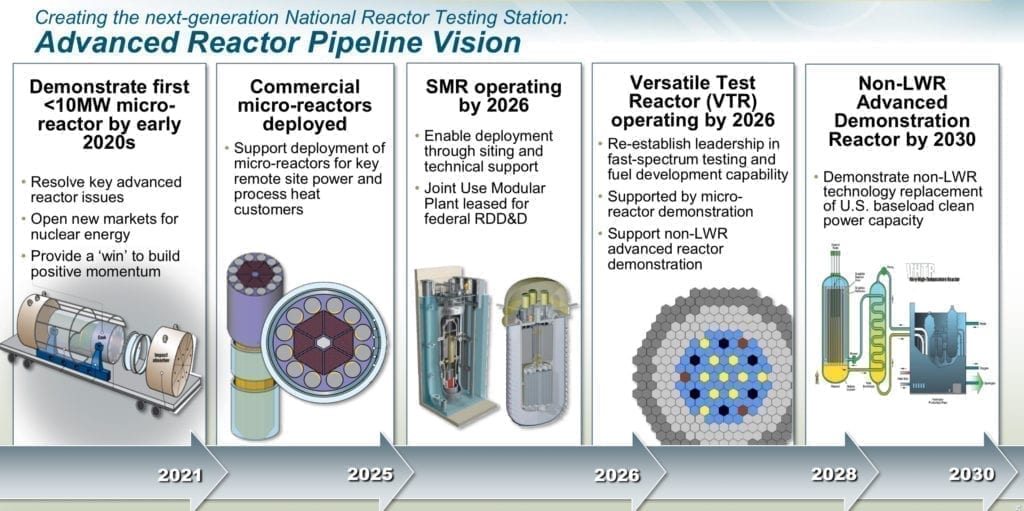Officials announce support program for job seekers – The Eastern New Mexico News – easternnewmexiconews.com
Officials announce support program for job seekers – The Eastern New Mexico News easternnewmexiconews.com
“job” – Google News…
Your Source for Energy Jobs & Industry News
Officials announce support program for job seekers – The Eastern New Mexico News easternnewmexiconews.com
“job” – Google News…
Program helps job seekers with ABCs of manufacturing Youngstown Vindicator
“job” – Google News…
The post DOE Launches Program to Demonstrate Advanced Nuclear Reactors Within 5 Years appeared first on POWER Magazine.

Bolstered by $ 230 million in Congressionally appropriated funding, the Department of Energy (DOE) has officially launched the Advanced Reactor Demonstration Program (ARDP) to help U.S.-based private developers of advanced nuclear reactors demonstrate their technology in the U.S.
Much anticipated by industry, the program formally established under the Office of Nuclear Energy program on May 14 is one of three major government-led and Congressionally supported initiatives to boost U.S. nuclear energy research and development. Congress has also appropriated $ 305 million for fuel cycle research and development, and $ 267 million for reactor concepts research, including for the industry-led Advanced Reactor Concepts program and the Versatile Advanced Test Reactor.

The post Nation’s Largest Community Solar Program Set to Launch appeared first on POWER Magazine.
Florida Power & Light (FPL) on March 3 received approval from state regulators to launch the nation’s largest community solar program. FPL’s $ 1.8 billion SolarTogether project will more than double the amount of available community solar power nationwide.
The program, unanimously approved Tuesday by the Florida Public Service Commission (FPSC), adds almost 1.5 GW of solar power generation capacity across the state. It includes 20 solar arrays, each with about 74.5 MW of generation capacity—just below the 75-MW threshold that would require more regulatory oversight of the projects. The new projects are all expected to come online over the next year.
“This program represents significant forward progress for the solar landscape of not only Florida, but the entire United States,” said Eric Silagy, president and CEO of FPL, on Tuesday. “For years, access to solar energy for many Floridians was not economical or easily accessible.…
Battelle Energy Alliance—the management and operating contractor for the Idaho National Laboratory (INL)—selected GE Hitachi Nuclear Energy’s (GEH’s) PRISM technology to support the U.S. Department of Energy’s Versatile Test Reactor (VTR) program.
The VTR program is expected to accelerate the development of fuels and materials for U.S. advanced reactors, utilizing fast neutron spectrum technology. Rather than producing electricity, the VTR will conduct irradiation testing for fuels, materials, and equipment to be used in rapidly evolving designs for advanced reactors brought forward by U.S. companies, as well as public and private research institutions.
In October, the INL awarded nearly $ 3.9 million in funding through the VTR program for 13 university-led projects to develop instrumentation and tools needed to monitor and conduct experiments in the fast spectrum reactor.
The university-led projects selected for funding were:
| University of Pittsburgh | Disruptive Nuclear Technology: Resonance Sensors and Inductive Signal Transmission through Hermetic Walls | $ 450,000 |
| University of Wisconsin – Madison | Miniature Scale Liquid Metal Oxygen Purification and Measurement System | $ 350,000 |
| University of Utah | Development of Experiment Vehicle for Analyzing the Chemistry of Irradiated Molten Salt | $ 450,400 |
| Texas A&M University | Development of Innovative Measurement Techniques for Fission Product Transport Quantification | $ 250,000 |
| Oregon State University | In Situ Mechanical and Corrosion Testing | $ 440,000 |
| University of New Mexico | Preparatory Out-of-pile Lead Loop Experiments to Support Design of Irradiation Test Loop in VTR | $ 450,000 |
| North Carolina State University | VIM for VTR: Holistic Approach to Design and Construction | $ 319,000 |
| Texas A&M University | Rabbit System Design and Demonstration | $ 400,000 |
| Abilene Christian University | Investigation of Instrumentation, Data Analytics, and Simulation Synergies for the Versatile Test Reactor | $ 150,000 |
| Massachusetts Institute of Technology | Advanced Data Acquisition and Simulation with Live Data Supporting VTR Experiments | $ 150,000 |
| University of Idaho | Advanced Molten Salt Flow Sensor | $ 100,000 |
| Colorado School of Mines | Big, Deep, and Smart Data to Support VTR Experiment Design and Validation | $ 169,000 |
| Georgia Tech | IBD Power Monitor for the VTR Experimental Program | $ 196,000 |
“The VTR is a vital and strategic project for the U.S.…